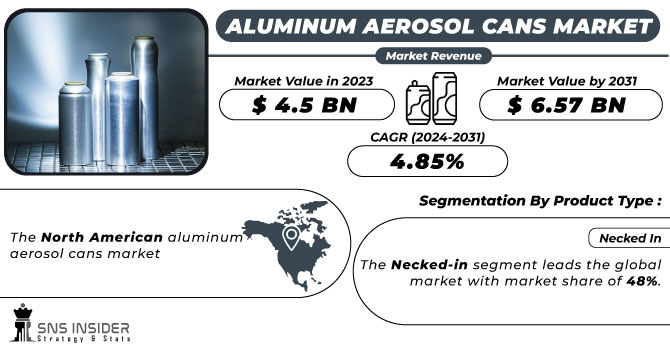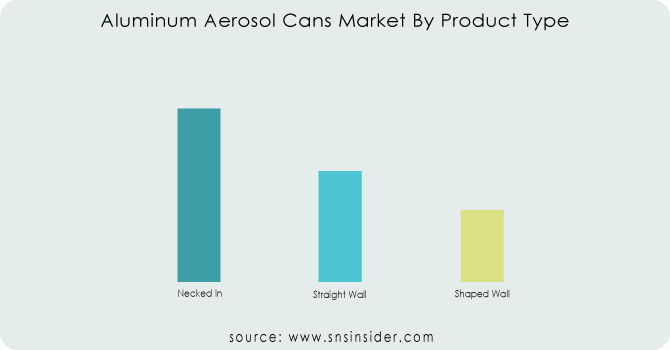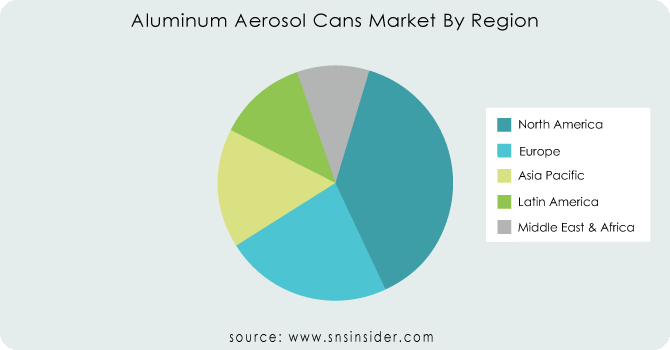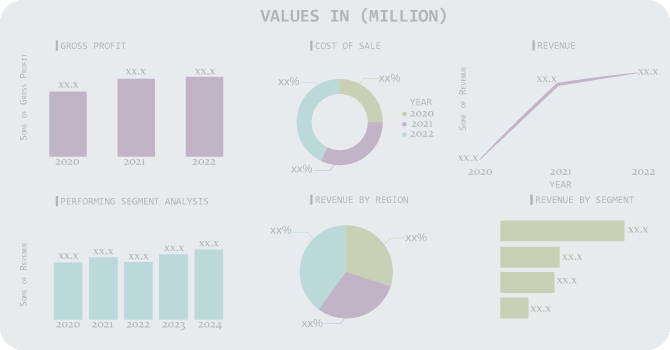Aluminum Aerosol Cans Market report scope & overview:
Aluminum Aerosol Cans Market Size was valued at USD 4.5 billion in 2023 and is projected to reach USD 6.57 billion by 2031 and grow at a CAGR of 4.85% over the forecast period 2024-2031.
The aluminum aerosol cans market is poised for significant growth driven by rising disposable income, changing lifestyles, and urbanization, particularly in the cosmetic and personal care sectors. The increasing adoption of these cans for food storage, automotive packaging, and agricultural products enhances market expansion. Consumer awareness of eco-friendly, hygienic, and convenient packaging further propels demand, as does the 100% recyclability and high quality of aluminum cans.

Get More Information on Aluminum Aerosol Cans Market - Request Sample Report
Manufacturers are advancing the market with various designs, lightweight, cost-effective products, and sustainability initiatives. Rapid trends in e-commerce and online shopping bolster sales, while promotional activities on social media increase brand engagement. The market is expected to see short-term growth from standardized product demand and urbanization, medium-term growth from innovations in emerging economies like China, and long-term growth from government initiatives, R&D, and sustainability investments.
MARKET DYNAMICS:
KEY DRIVERS:
-
The confluence of rising disposable income, changing lifestyles, and accelerating urbanization is acting as a key driver of market expansion.
-
The booming popularity of cosmetics and personal care products is driving a surge in the use of aluminum aerosol cans for packaging.
End-use sectors like industrial, household products, and cosmetics have been driving significant market growth, generating substantial revenue in recent years. Presently, manufacturers are creating aluminum aerosol cans that are high-strength, lightweight, and corrosion-resistant. Furthermore, the storage of various products such as sanitizers, skincare, deodorants, and fragrances are boosting demand for aluminum aerosol cans.
RESTRAINTS:
-
The price of aluminum is subject to fluctuations due to market demand, geopolitical issues, and supply chain disruptions.
-
Developing and implementing advanced printing and design technologies can be expensive.
Developing and implementing advanced printing and design technologies can be costly, necessitating significant investments in research and development. This financial burden can be particularly challenging for small and medium-sized enterprises, which may lack the resources and capital to invest in the latest technological innovations. These companies often struggle to compete with larger corporations that have the financial capacity to adopt and integrate cutting-edge technologies more rapidly.
OPPORTUNITIES:
-
Market players are increasing their investment and engaging in more research and development activities.
Recent technological advancements in printing and design have revolutionized the creation of aluminum aerosol cans, enabling highly innovative and customizable solutions. These developments allow brands to differentiate themselves more effectively in the market and engage consumers on a deeper level. Advanced printing techniques facilitate intricate and vibrant designs, while modern design capabilities enable unique shapes and features tailored to specific brand identities.
-
Government efforts are aimed at encouraging the use of products that can be recycled or reused.
CHALLENGES:
-
Competition from Alternative Packaging.
There is growing competition from alternative packaging materials such as plastics, glass, and other eco-friendly options like biodegradable and compostable materials. These alternatives can be more cost-effective or have a smaller environmental footprint, posing a threat to the aluminum aerosol can market.
-
While aluminum is recyclable, the process requires significant infrastructure and consumer participation.
IMPACT OF RUSSIA-UKRAINE WAR
The war in Ukraine has significantly impacted the aluminum aerosol can market. Disruptions to metal production and transportation in the region have caused a decrease in aluminum supply, driving prices up. The international price of aluminium surged 28% in 2022, reaching US$3,849 per tonne on 4 March, then settling back to US$3,398, approximately level with the price following a spike that occurred on 24 February, right after the invasion began. This price increase, coupled with market uncertainty due to the conflict, has led companies to hesitate on investments. The ripple effect extends beyond the aluminum market, impacting the global economy through increased costs of goods and services due to rising metal prices in general. Furthermore, sanctions and the need for companies to find alternative suppliers are causing a shift in how the aluminum market operates.
IMPACT OF ECONOMIC SLOWDOWN
An economic slowdown or recession can be a significant challenge for the aluminum aerosol can market. It reduced economic activity leads to lower demand from key consumer industries like packaging, potentially causing a glut of aluminum and driving prices down. This can squeeze profits for can manufacturers. Second, inflation often accompanying a slowdown, increases the cost of raw materials and operations, further pressuring margins. Additionally, a cautious investment climate during recessions can limit funding for innovation in can design and production, hindering the industry's ability to stay competitive in the long term.
KEY MARKET SEGMENTS:
By Product Type
-
Necked In
-
Straight Wall
-
Shaped Wall
By product type, the necked-in segment leads the global market with market share of 48%. These cans are widely adopted for packaging a variety of products, from automotive to cosmetics, due to their durability, flexibility, portability, and convenience, which drive market growth.

Need any customization research on Aluminum Aerosol Cans Market - Enquiry Now
By Capacity Type
-
Less than 100 ml
-
100 to 250 ml
-
251 to 500 ml
-
More than 500 ml
Aluminum aerosol cans ranging from 100 to 250 ml dominate the global market, a trend anticipated to persist in the coming years. Their popularity is particularly notable in the personal care and automotive sectors, where their convenient size is a key advantage. Despite the 100-250 ml segment leading the market, other can sizes are also experiencing robust growth and making substantial contributions to overall market revenue.
By End-use Industry
-
Cosmetics & Personal Care
-
Household Products
-
Automotive/Industrial
-
Others
In terms of end-use industry, the cosmetic and personal care sector is generating significant. The increasing use of cosmetic products for healthier skin and improved hair growth is boosting the sales of aluminum aerosol cans. Products like creams, lotions, deodorants, shaving creams, and sanitizers are key contributors to market growth.
REGIONAL ANALYSES
The North American aluminum aerosol cans market, particularly the United States, is set to dominate due to aluminum's high recyclability and growing emphasis on sustainability. The U.S. market is driven by increased consumer spending on cosmetic brands, a high standard of living, a rapidly growing automotive sector, and strong R&D activities. Manufacturers in the U.S. are focusing on sustainable packaging to reduce toxicity, supported by government initiatives promoting recycling.
Europe holds the second-largest market share, with significant demand in the personal care and beauty industry. Germany leads in market share, while the UK is the fastest-growing market in the region. The Asia-Pacific market is anticipated to grow at the fastest, fueled by technological innovations in printing and design that enable customizable and visually appealing cans. China leads the region due to the booming automotive and cosmetic sectors, along with rising demand for agricultural packaging solutions. India follows as the fastest-growing market in the Asia-Pacific region.

REGIONAL COVERAGE:
North America
-
US
-
Canada
-
Mexico
Europe
-
Eastern Europe
-
Poland
-
Romania
-
Hungary
-
Turkey
-
Rest of Eastern Europe
-
-
Western Europe
-
Germany
-
France
-
UK
-
Italy
-
Spain
-
Netherlands
-
Switzerland
-
Austria
-
Rest of Western Europe
-
Asia Pacific
-
China
-
India
-
Japan
-
South Korea
-
Vietnam
-
Singapore
-
Australia
-
Rest of Asia Pacific
Middle East & Africa
-
Middle East
-
UAE
-
Egypt
-
Saudi Arabia
-
Qatar
-
Rest of Middle East
-
-
Africa
-
Nigeria
-
South Africa
-
Rest of Africa
-
Latin America
-
Brazil
-
Argentina
-
Colombia
-
Rest of Latin America
KEY PLAYERS
The major key players are CPMC Holdings Ltd, Alucon PCL, Kian Joo Can Factory Bhd., Crown Holdings, Inc., China Aluminum Cans Holdings Ltd., CCL Industries Inc., Toyo Seikan Group Holdings Ltd, BWAY Corporation, Linhardt GmbH & Co KG, Nampak Limited, Montebello Packaging Inc, Ball Corporation, Euro Asia Packaging (Guangdong) Co., Ltd and other players.
CPMC Holdings Ltd-Company Financial Analysis

RECENT DEVELOPMENT
-
In December 2022, Trivium Packaging promised money for the UK Aerosol Recycling Initiative led by Alupro, a company that recycles aluminum packaging. This effort wants to teach people about recycling, figure out how much aerosol cans are recycled already, and come up with ways to recycle more in the UK. The goal is to make more people aware of aerosol recycling and get them involved all across the country.
-
In July 2022, Jamestrong Packaging, a company that makes food and aerosol cans, invested $6 million in a factory that makes aerosol cans. They plan to grow their business in Taree, New South Wales, by making more metal pieces for aerosol cans. This will help meet the growing demand for their products and create new jobs in the area with a new metal casting plant.
| Report Attributes | Details |
|---|---|
| Market Size in 2023 | US$ 4.5 Bn |
| Market Size by 2031 | US$ 6.57 Bn |
| CAGR | CAGR of 4.85% From 2024 to 2031 |
| Base Year | 2023 |
| Forecast Period | 2024-2031 |
| Historical Data | 2020-2022 |
| Report Scope & Coverage | Market Size, Segments Analysis, Competitive Landscape, Regional Analysis, DROC & SWOT Analysis, Forecast Outlook |
| Key Segments | • By Type (Flip Chip Scale Package, Flip Chip Ball Grid Array, Wafer Level Chip Scale Packaging, 5D/3D, Fan Out Wafer-Level Packaging, Others) • By End User (Consumer Electronics, Healthcare, Industrial, Aerospace And Defense, Automotive, Other) |
| Regional Analysis/Coverage | North America (US, Canada, Mexico), Europe (Eastern Europe [Poland, Romania, Hungary, Turkey, Rest of Eastern Europe] Western Europe] Germany, France, UK, Italy, Spain, Netherlands, Switzerland, Austria, Rest of Western Europe]), Asia Pacific (China, India, Japan, South Korea, Vietnam, Singapore, Australia, Rest of Asia Pacific), Middle East & Africa (Middle East [UAE, Egypt, Saudi Arabia, Qatar, Rest of Middle East], Africa [Nigeria, South Africa, Rest of Africa], Latin America (Brazil, Argentina, Colombia Rest of Latin America) |
| Company Profiles | CPMC Holdings Ltd, Alucon PCL, Kian Joo Can Factory Bhd., Crown Holdings, Inc., China Aluminum Cans Holdings Ltd., CCL Industries Inc., Toyo Seikan Group Holdings Ltd, BWAY Corporation, Linhardt GmbH & Co KG, Nampak Limited, Montebello Packaging Inc, Ball Corporation, Euro Asia Packaging (Guangdong) Co., Ltd |
| Key Drivers | • The confluence of rising disposable income, changing lifestyles, and accelerating urbanization is acting as a key driver of market expansion. • The booming popularity of cosmetics and personal care products is driving a surge in the use of aluminum aerosol cans for packaging. |
| Key Restraints | • The price of aluminum is subject to fluctuations due to market demand, geopolitical issues, and supply chain disruptions. • Developing and implementing advanced printing and design technologies can be expensive. |

